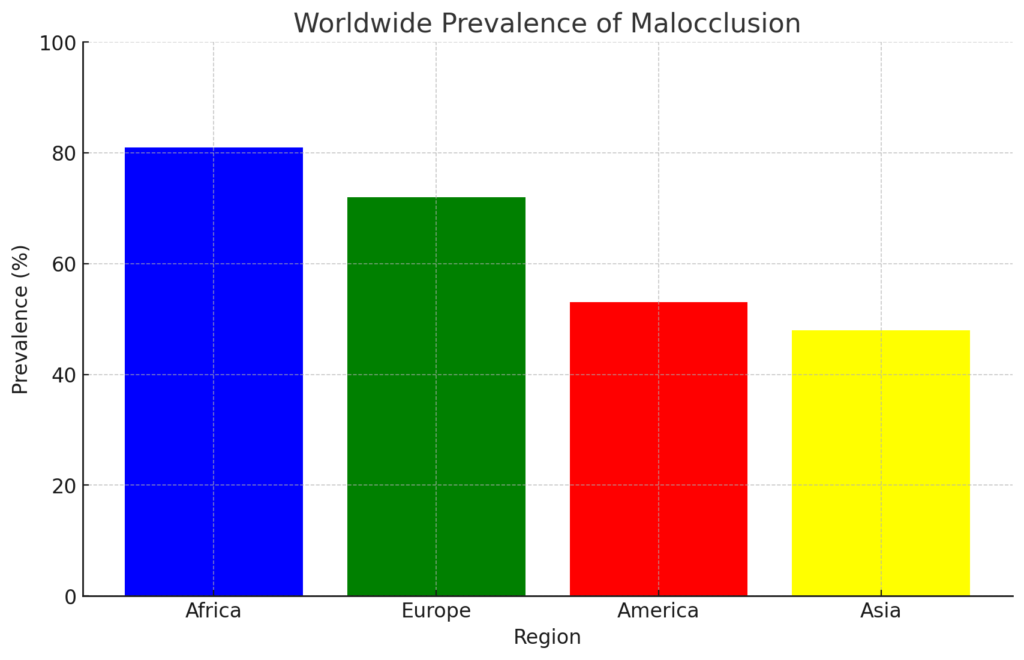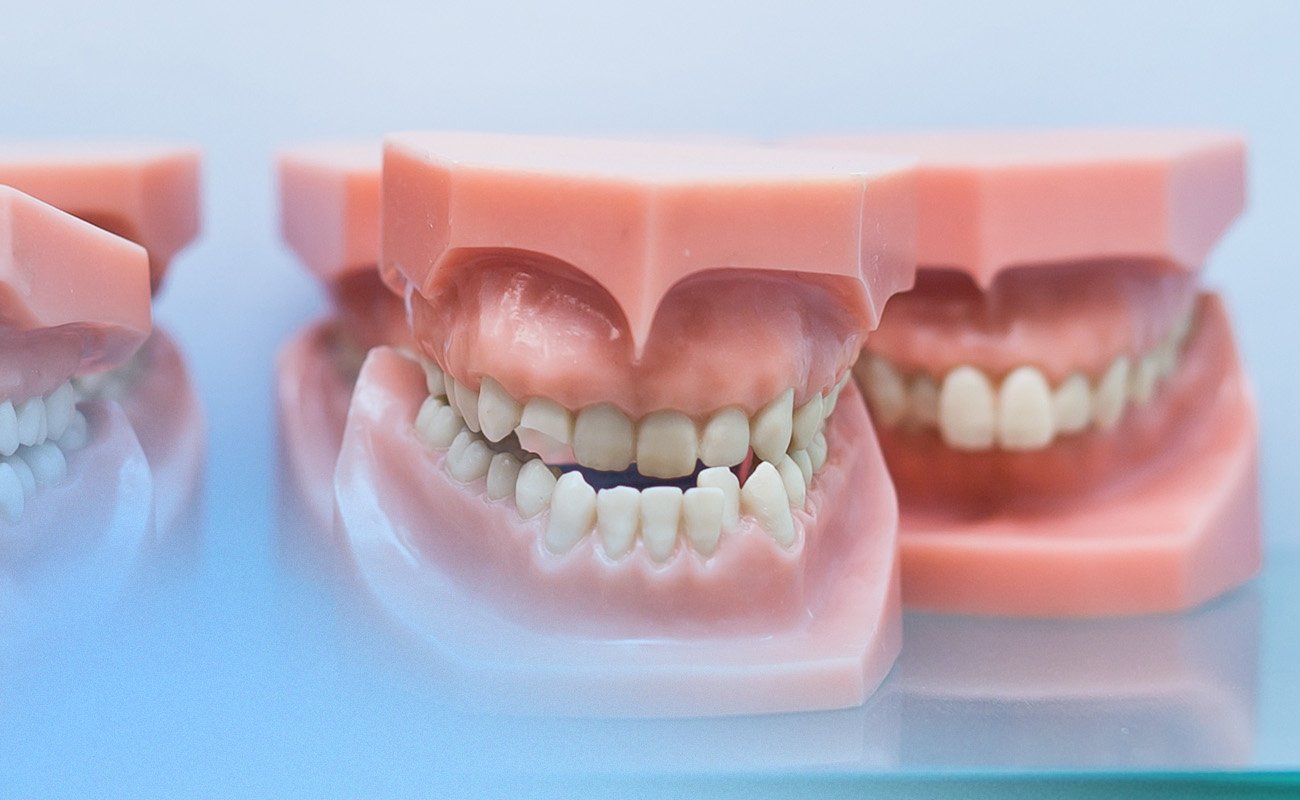Underbites, where the lower teeth protrude outward beyond the upper teeth, can lead to a variety of oral health issues if left untreated. In this article, we’ll examine the various causes of underbites, from genetics to childhood habits. We’ll discuss the potential consequences of allowing an underbite to go uncorrected, like chewing impairment, TMJ disorders, and facial deformities. We’ll explore the different types – from mild underbite to severe and from dental to functional and the orthodontic treatment options available, such as braces, surgery, and retainers. Finally, we’ll provide recommendations for proper post-treatment care of an underbite to ensure the stability of the realigned bite long-term.
Underbite
An underbite is a dental condition characterized by the lower teeth extending outward farther than the upper front teeth. This misalignment is also known as a Class III malocclusion. Underbites can range from mild, where the lower front teeth are only slightly in front of the upper front teeth, to severe, which can cause noticeable jaw protrusion and various symptoms such as difficulty speaking, chewing, and breathing.
Underbites are a type of dental malocclusion that affects a significant portion of the population. Although exact prevalence rates may vary, it is estimated that underbites affect around 5-10% of individuals worldwide. Underbites can worsen with age if left untreated. As individuals age, their teeth and jaw continue to develop and change, which can exacerbate the existing misalignment.

Causes of Underbite
There are several primary causes of underbites:
- Genetics: The most common cause of underbites is hereditary, meaning it can be passed down through family members.
- Jaw malformation: Sometimes, an individual’s jaw might grow abnormally or be malformed, leading to an underbite.
- Teeth misalignment: If the teeth themselves are not positioned correctly in the mouth, it can contribute to the development of an underbite.
- Tongue thrusting: Constant tongue pressure against the lower teeth can cause them to move forward over time.
- Thumb sucking as a child: Prolonged thumb sucking can lead to the development of an underbite, especially if the habit continues past the age of 5 or 6 years old.
See also: Underbite Vs Overbite: Causes, Effects, and Treatments
Consequences of Untreated Underbite
Untreated underbites can result in various complications. Here are the potential consequences of this dental misalignment:
- TMJ Pain: Untreated underbites can lead to Temporomandibular Joint (TMJ) pain. The misalignment of the jaw can create stress on the joint, causing discomfort and pain.
- Mouth Breathing: An underbite may cause difficulties with proper nasal breathing, leading to habitual mouth breathing. This can increase the risk of respiratory infections and contribute to dry mouth.
- Sleep Apnea and Snoring: Untreated underbites increase the risk of developing sleep apnea and snoring due to compromised airway passages caused by misaligned teeth and jaws.
- Bruxism: The misalignment of teeth in an underbite can lead to bruxism, or teeth grinding, which can cause tooth and jaw pain, and damage the tooth enamel.
- Increased Risk of Tooth Decay and Gum Disease: A misaligned bite can make it more challenging to maintain proper oral hygiene, increasing the risk of tooth decay and gum disease.
- Aesthetic Issues: Untreated underbites can potentially create aesthetic issues, affecting an individual’s facial appearance, and impacting their self-esteem and confidence.
- Speech Issues: Underbites can cause speech problems, as misaligned teeth can affect pronunciation and make it difficult to articulate certain sounds.
- Chipping and Breaking of Teeth: Having an untreated underbite may lead to an increased risk of chipping or breaking teeth due to the uneven distribution of forces when biting and chewing.
- Pain in the Jaw When Eating: People with underbites might experience pain in their jaw when eating due to the misalignment of the jaw and teeth, causing stress and strain on the jaw muscles.
- Increased Risk of Trauma to Lower Teeth: Untreated underbites can expose lower front teeth to a greater risk of trauma due to their protruding position.
- Increased Risk of Headaches and Earaches: Persistent jaw strain and misaligned bites can increase the risk of developing headaches and earaches, as the stress and tension can extend to the adjacent facial muscles and nerves.
- Uneven Wear of the Enamel: Misaligned teeth in an underbite can cause uneven wear of the tooth enamel, leading to potential tooth sensitivity and damage over time.
Types of Underbite
Underbites can be categorized based on their origins:
Dental Underbite: This type of underbite arises solely from the misalignment of the teeth, not from the jawbone. It occurs when the lower front teeth are positioned in front of the upper front teeth due to factors like crowding or spacing in the lower teeth.
Skeletal Underbite: Caused by the physical position of the jawbones, this underbite occurs when the lower jawbone (mandible) is more prominent or more forward than the upper jawbone (maxilla). It’s often a genetic trait, inherited from one’s family.
Functional Underbite (Pseudo Underbite): This type isn’t due to bone structure or teeth positioning but develops because of a functional shift of the upper jaw. It can result from habits or conditions like thumb sucking or an issue with the temporomandibular joint.
Underbites can be also categorized based on their severity:
Mild Underbite: A mild underbite is a subtle misalignment of the lower front teeth that extends slightly beyond the upper front teeth. This type of underbite is less noticeable and may not cause significant oral health or functional issues. In some cases, individuals with a mild underbite may not even be aware of their condition, if it doesn’t interfere with their daily activities.
Moderate Underbite: A moderate underbite is more pronounced than a mild underbite, with the lower front teeth extending noticeably beyond the upper front teeth. This can result in functional challenges, such as difficulty biting or chewing, as well as aesthetic concerns.
Severe Underbite: Severe underbites involve a significant protrusion of the lower jaw, causing the lower front teeth to extend far beyond the upper front teeth. This type of underbite can lead to multiple complications, including difficulties with speech, eating, and overall oral health. A severe underbite may be caused by genetic factors or an underlying jawbone deformity.

Treatment Options
Having previously discussed the causes and types of underbite, let’s check the various treatment options available to address different severities and causes of this dental misalignment.
Braces
One common treatment for a mild underbite is the use of braces. These appliances can help to gradually realign the teeth by applying consistent pressure over time. Dentists might recommend traditional metal braces or ceramic braces, depending on the individual’s needs and preferences.
See also: Can Braces Fix Gaps?
Invisalign and Clear Aligners
Another option for treating an underbite is the use of Invisalign or clear aligners. These are similar to braces, but they are nearly invisible and can be removed for eating and cleaning. They still apply pressure to shift the teeth but with a more discreet appearance.
See also: Are At-Home Teeth Aligners Safe?
If you are looking for an affordable and efficient teeth straightening solution then invisible braces are a great choice. Here is a selection of companies to help you with your selection.

Byte
An affordable option with refundable impression kits, free HyperByte, and a Byte for Life guarantee.
Check out Byte Aligners
Candid
A hybrid of in-office and at-home treatment that provides 1-on-1 orthodontist support.
Check out Candid AlignersPalate Expanders
In some cases, a palate expander may be utilized to widen the upper jaw. This can correct the underbite if the cause is related to a narrow upper arch. Palate expanders often work best for young patients whose jaws are still growing.
Tooth Extraction
If teeth are crowded or overcrowded in the mouth, a tooth extraction may be necessary. By removing one or more teeth, space is created for proper alignment using braces or clear aligners.
Surgery in Severe Cases
Surgery may be needed in more severe underbite cases. This involves repositioning the jaws to achieve a proper bite. However, in cases of mild underbite, surgery is less likely to be required.
At What Age Should You Fix an Underbite?
It’s best to address an underbite early in life, while the jaw is still developing. Orthodontic treatment can usually begin between ages 7 and 14. Starting treatment earlier can lead to better outcomes and potentially avoid more invasive procedures later on.
Post-Treatment Care
After undergoing treatment for an underbite, it’s essential to follow post-treatment care recommendations. The long-term success of the treatment depends on consistent and proper maintenance. Here are the necessary care steps.
Importance of Wearing Retainers After Braces Removal
After the removal of braces, it is important to wear retainers to maintain the alignment of your teeth and prevent any relapse. Retainers help stabilize your teeth and hold them in their new positions, giving the supporting bone and gums time to adapt. It is common for orthodontists to recommend wearing retainers full-time for several months and then transitioning to nighttime use only.
Regular Dental and Orthodontic Check-Ups
Following underbite correction, regular dental and orthodontic check-ups are essential to maintain optimal oral health and monitor the stability of the corrected alignment. Dentists and orthodontists will provide professional cleanings and ensure that the retainers are functioning effectively. They can also identify and address any potential concerns or complications early, ensuring the long-term success of the treatment.
Addressing Any Residual Issues or Complications
While most patients enjoy a successful outcome after underbite treatment, some may experience residual issues or complications. In such cases, it is important to consult your dental team for appropriate interventions. These may include additional orthodontic treatment, surgical intervention, or preventive measures to avoid further complications.
Frequently Asked Questions
What are the common treatment options for mild underbite?
There are several treatment options for mild underbite, depending on the severity and the patient’s age. Some common treatments include braces, Invisalign, orthodontic appliances, and dental work. In most cases, braces are the go-to treatment for underbites. Dental work may involve tooth extraction or reshaping, while orthodontic appliances can help adjust the position of the lower jaw.
Can Invisalign correct a mild underbite?
Invisalign is a popular and effective alternative to braces for treating mild underbites. These clear aligners are custom-made to gradually shift the teeth into proper alignment. Invisalign is suitable for mild to moderate underbites and is often preferred due to its discreet and comfortable design. However, it’s important to consult with a qualified orthodontist to determine if Invisalign is the right treatment option for your particular situation.
Do mild underbites worsen over time?
Mild underbites may worsen over time, particularly if left untreated. As the lower jaw continues to grow, the misalignment between the upper and lower teeth can become more pronounced, leading to more severe underbite conditions. Early intervention is key to prevent the mild underbite from progressing and to avoid potential issues with oral health, speech, and facial appearance.
Is surgery required for mild underbite correction?
Surgery is typically not required for mild underbite correction. Non-invasive treatments like braces, Invisalign, and orthodontic appliances are usually sufficient to correct mild underbites. Surgery is generally recommended for more severe cases where such treatments prove to be ineffective or when the patient has a skeletal issue that cannot be addressed through orthodontic methods alone.
How can adults with mild underbite be treated?
Adults with a mild underbite can be treated using similar methods as younger patients, such as braces, Invisalign, and orthodontic appliances. However, adult patients may experience a longer treatment time due to the slower movement of teeth in mature individuals.
Sources
Lombardo, G., Vena, F., Negri, P., Pagano, S., Barilotti, C., Paglia, L., Colombo, S., Orso, M., Cianetti, S., Worldwide prevalence of malocclusion in the different stages of dentition: A systematic review and meta-analysis. Eur J Paediatr Dent. 2020 Jun;21(2):115-122. DOI: 10.23804/ejpd.2020.21.02.05. Available online at: https://pubmed.ncbi.nlm.nih.gov/32567942/
Cenzato, N., Nobili, A., Maspero, C., Prevalence of Dental Malocclusions in Different Geographical Areas: Scoping Review. Dent J (Basel). 2021 Oct; 9(10): 117. DOI: 10.3390/dj9100117. Available online at: https://www.ncbi.nlm.nih.gov/pmc/articles/PMC8534899/
Zere, E., Chaudhari, P. K., Sharan, J., Dhingra, K., Tiwari, N., Developing Class III malocclusions: challenges and solutions. Clin Cosmet Investig Dent. 2018; 10: 99–116. DOI: 10.2147/CCIDE.S134303. Available online at: https://www.ncbi.nlm.nih.gov/pmc/articles/PMC6016584/
Hong Liu, Jian-Xue Li, Non-surgical treatment of an Angle Class III malocclusion in adults. Int J Clin Exp Med. 2013. Available online at: https://www.ncbi.nlm.nih.gov/pmc/articles/PMC3798208/

